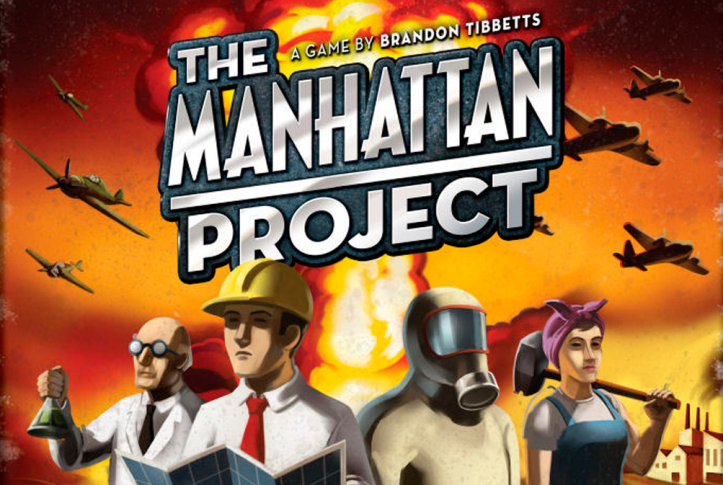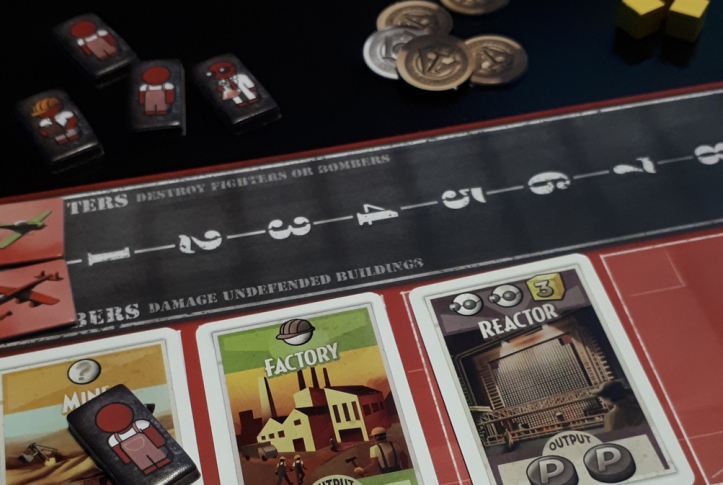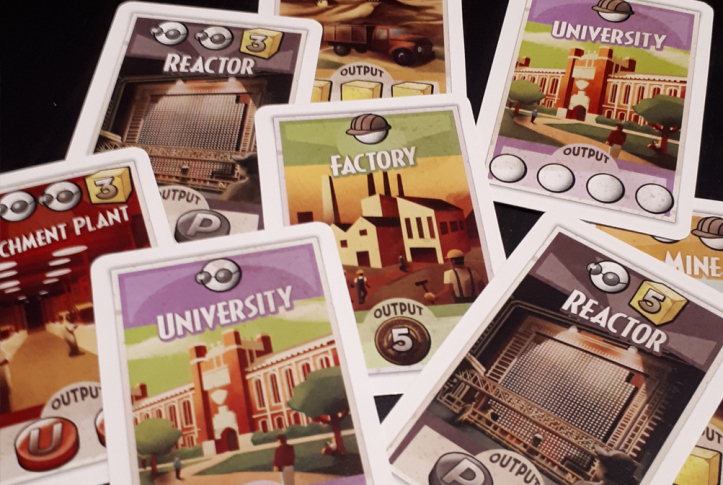 Title: Manhattan Project
Title: Manhattan Project
Designer: Brandon Tibbetts
Artist(s): Viktor Csete, Clay Gardner, Sergi Marcet
Publisher: Minion Games
Released: 2012
Players: 2-5
Length: 120 Mins
More Info: Board Game Geek – Manhattan Project
RUNDOWN:
In Manhattan Project players are the leaders of great nations’ atomic weapons, each chasing that more elusive prize… The Bomb. Manhattan project is a worker placement game where luck is minimized and your own choices are the catalyst of your success or failure. Players will take turns placing their workers to the game boards, either the main board or their own, and generating new workers or resources to be used. Unlike most games of its genre, Manhattan Project does not have fixed rounds. Play simply flows from one players turn to another until the victory condition is met. Victory in Manhattan Project is achieved by reaching a set number of Victory Points which varies based on the number of players.

Each turn a player may place one of their workers to the main game board and no more, they will then resolve the action and get the rewards. They may then place any workers they have left over on to their own player board. At the beginning of the game this is not going to be viable as the players won’t have any spaces there to take workers, but as play progresses and they build new structures to their boards, they can use them. Alternatively, players may choose to recall their workers. When they do this they will take all of their used workers from both boards back and they will be free to use them again on their next turn. Doing so will allow you to continue with your own plans, but will open up any spaces your workers were occupying on the main board, allowing others to take those spaces and so the decision to recall workers shouldn’t be taken too lightly.

At the beginning of the game, players will have an empty player board, waiting for new buildings to be constructed on it, and a handful of basic labourer workers, which can be upgraded to more specialized scientists and engineers. Buildings will come out along a building track with their cost getting cheaper the long they have been on display. These buildings include Universities, Mines, Factories, Enrichment Plants and Reactors. Players will use these to generate more scientists, dig for precious Yellowcake and turn that Yellowcake in the Plutonium or Uranium that is needed for bombs.
Gaining Victory Points however is the key to winning the game though, and the way players do that is by actually building and testing bombs. To do this, players will take bomb cards from an allotted supply whenever somebody takes the Design Bomb action on the main gam board. The player who took the action will always get the first and last pick from the bomb cards. In a 2-player game for example, 3 bomb cards are available and the player taking the action will get the first and third picks of those three. These cards will go into the player’s hands until they choose to build them.

When they do build them, players will put the bomb they are building next to their player boards and fulfil the requirements for its construction. Bombs take many workers, 5 or 6 is not atypical, and will require plutonium or uranium depending on the kind of bomb it is. When it is complete, the player scores the number of victory points at the bottom of the bomb card. Plutonium bombs however have one further stage to their construction. Plutonium bomb cards have 2 values at the bottom of the card, one that is significantly higher value than the other. To score these increased points, a player must test a plutonium bomb by taking an Implosion Test action. To do this they will take their completed bomb and place it, face down, on the bottom of the bomb deck. They have detonated it and learned important things in the field of plutonium bombs, doing this will allow them to score the increased value for all future plutonium bombs they construct, however they will lose the victory points the bomb that has been detonated. Pursuing these extra points is a gamble that a player will get more higher value plutonium bombs in the future, to make up for the significant cost the player has paid.

All of this bomb making isn’t just a friendly race however, these are rival nations desperately trying to be the first to master this new weapon after all, so players can take some aggressive actions to slow their opponents ascent to nuclear superpowers. While you can never drop one of your precious VP loaded atomic weapons on your opponents, players can send out wings of conventional bombers to damage their buildings. By doing this you will render a building inoperable until it’s owner sends a worker to the repair space on the main board to remove the damage. Players can also send out fighters to target their opponent’s aircraft, either fighters or bombers, removing them from the game. Lastly, players can engage in espionage. Taking this action allows you to place one of your workers onto an opponent’s building, taking the return for placing a worker there themselves and rendering it ‘full’ so they player who owns it cannot use it. These actions are strong, but expensive, so using them needs to be measured. Taking actions to hinder your opponent can sometimes slow your own progress as well.
FINAL THOUGHTS:
Manhattan Project is a fast moving worker placement game with almost no down time. The game has a rhythm of sorts, where you are placing workers and retrieving them at just the right time to hit all your goals. That feels fantastic. You can see your engine growing in front of you and you are always preparing for the next key move. Even when the whole board is blocked however, when your engine maybe isn’t running so smoothly, there is still always a good choice available to you, even the smallest turns for you will still be helpful in the long run.
That being said though, Manhattan Project is mean. We won’t sugar-coat it. A key aspect to the game is the espionage and bombing of other players. Screwing up their plans is very frequently going to be essential to your own success and games are often decided by a key bombing run to disable an enrichment plant or a sneaky espionage play to take resources you need from another player’s mine. To not partake in the aggressive side of the game, will affect the overall balance of the game, and unfortunately that turns a great game into one that maybe isn’t for everyone.
Manhattan Project is a great game, it has clever design behind it and it will inevitably influence future worker placement games… But due to its reliance on aggressive take-that style gameplay Token Express cannot recommend it. If that sounds like fun to you however, go get this game. You can’t do better.
Advertisements Share this:





